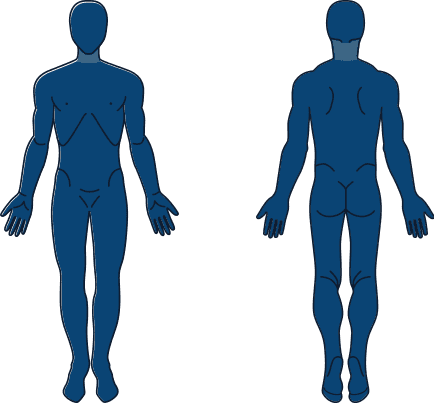What is a biceps tendon Injury?
- Tendons attach muscle to bone. In the shoulder, the biceps tendon can be injured in an instant or gradually over time. Common instantaneous injuries include strains and tears. Common gradual injuries include tendinosis (small micro-tears), which may or may not include inflammation. Another general term for gradual injuries of the biceps tendon is tendinopathy.
What are some of the typical causes of biceps tendon injury?
- Instantaneous injuries – occur when the arm is pulled in an awkward & sudden movement, especially when the muscle is engaged.
- Gradual injuries – occur with repetitive motion and overuse of the arm.
What are the symptoms of biceps tendon Injury?
- Pain at the front of the shoulder, especially with lifting objects and raising the arm forward.
- Arm weakness
What are some initial treatments?
- Instantaneous injuries – typically need to be evaluated to determine the extent of injury. Ice and anti-inflammatories may help with pain.
- Gradual injuries – Rest, Ice, anti-inflammatories, gentle range of motion exercises.
What is frozen shoulder?
- Stiffness and pain in the shoulder which prevents normal use of the affected arm.
What are some of the typical causes of biceps tendon injury?
- Causes of frozen shoulder vary. At times, it may be the result of an injury that prevents the normal use of the shoulder, other times there is no known cause. There is some thought that scar tissue may play a role in the development of frozen shoulder.
What are the symptoms of frozen shoulder?
- Shoulder pain
- The inability to lift and reach with the affected arm
What are some initial treatments?
- Rest, Ice, anti-inflammatories, gentle range of motion exercises, physical therapy
What is a glenoid labral injury?
- The shoulder is essentially a ball and socket joint, however the socket also known as the glenoid, is very shallow. The glenoid labrum is rim of fibrous cartilage that attaches around the socket of the shoulder joint and deepens the socket.
- Injuries to the labrum involve tears at one or more locations around the rim.
What are some of the typical causes of a labral injury?
- Labral tears can happen immediately (falls on arm, forced movements, lifting heavy objects or forceful throwing) or gradually over time with repetitive motion.
What are the symptoms of a labral injury?
- Shoulder pain, arm weakness,
- The inability to lift and reach with the affected arm
What are some initial treatments?
- Rest, Ice, anti-inflammatories, gentle range of motion exercises, physical therapy
What is a Rotator Cuff Injury?
- The rotator cuff is a group of tendons that help move the shoulder and stabilize the joint.
- These tendons can be torn instantly or injured gradually over time.
- An injury to these tendons can lead to impingement syndrome which is a pinching of the rotator cuff tendons against the bones overlying the joint.
- Another common manifestation of rotator cuff injury is bursitis. The bursa is potential space between the rotator cuff and the deltoid muscle and overlying bones. It allows the rotator cuff tendons to slide smoothly beneath these structures. An injury to the rotator cuff can lead to inflammation of this space.
What are some of the typical causes of a rotator cuff injury?
- Rotator cuffinjuries can happen immediately (falls on arm, forced movements, lifting heavy objects or forceful throwing) or gradually over time with repetitive motion.
What are the symptoms of a rotator cuff injury?
- Shoulder pain, arm weakness,
- The inability to lift and reach with the affected arm
What are some initial treatments?
- Rest, Ice, anti-inflammatories, gentle range of motion exercises, physical therapy
- Instantaneous tears may require surgical repair
What is a shoulder separation?
- A shoulder separation is a sprain or tear of the ligaments that hold the clavicle (collarbone) to the acromion (bony point arising off the back of the scapula) and the coracoid (bony process arising off the front of scapula) that causes a widening of the space between the clavicle and the shoulder joint.
What are some of the typical causes of a shoulder separation?
- Falls on shoulder, outstretched hand, or elbow.
What are the symptoms of a shoulder separation?
- Shoulder pain, decreased range of motion, swelling, bony bump at top of shoulder
What are some initial treatments?
- Ice, anti-inflammatories, possible immobilization
What is a shoulder subluxation and dislocation?
- The main bony articulation of the shoulder joint is the humeral head (ball) and glenoid (socket).
- Support for this articulation is provided by the labrum (cartilage rim), the capsule (forms ligaments for stability), and the rotator cuff muscles.
- A shoulder subluxation is where the humeral head slips partially out of the socket
- A shoulder dislocation is where the humeral head is completely out of the socket.
What are some of the typical causes of a shoulder subluxation and dislocation?
- Falls on outstretched arm
- Direct blows to shoulders
- Forcing the arm in awkward positions
- Some people can naturally sublux and/or dislocate their shoulders on command or with every day activities
What are the symptoms of a shoulder subluxation and dislocation?
- Shoulder pain, arm weakness
- The inability to lift and reach with the affected arm
- Numbness or tingling in the shoulder or arm
- “Loose” feeling shoulder
- Shoulder deformity
What are some initial treatments?
- Subluxations are treated with rest, ice, anti-inflammatories, gentle range of motion exercises, physical therapy to strengthen the muscles that stabilize the shoulder
- Dislocations require relocation by trained personnel
